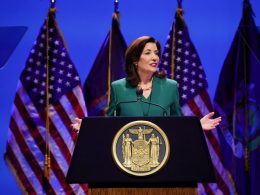I’ve got an idea for a new football franchise: the Brooklyn Jews. Our mascot will be a rabbi, clad in a black hat and a long coat. Whenever the team scores a touchdown, he’ll bow his head back and forth in prayer. Just kidding.
I’m Jewish, so I can make that joke. But we all know that nobody — literally, nobody — would think such a mascot was OK.
So why are we OK with calling the Kansas City football team the “Chiefs”?
The Washington Redskins are gone, replaced by the Commanders. So are the Cleveland Indians, who were rebranded as the Guardians.
But we still have the Chiefs, who compete in their third straight Super Bowl today. They were named after a white man, Mayor Harold Roe Bartle, who helped bring the team to Kansas City from Dallas in 1963. Bartle’s nickname was “the Chief,” so the team took his name as well.
Its first logo didn’t look anything like Harold Bartle, however. It was an “Indian” warrior in moccasins and a headdress, carrying a football and a tomahawk.
The Chiefs replaced that with an arrowhead. They also retired Warpaint, a horse that was ridden by a man in Native American style headdress. After touchdowns, it would prance across the field.
But the tomahawk lives on, in the team’s rituals. Fans sing an Indian “war chant” while flapping their arms up and down.
The “tomahawk chop” began at Florida State University in the late 1940s to support the school’s new football team, the Seminoles. It didn’t get to Kansas City until 1990, when the Northwest Missouri State marching band — led by an FSU graduate — played the war chant at a Chiefs game.
Now it’s the Chiefs’ signature move. Because, you know, that’s what Native Americans do. They sing war chants, and they chop you up with tomahawks.
I challenge you to tell me how that’s any less offensive than, say, my imagined rabbi praying for the Brooklyn Jews.
And if that doesn’t convince you, consider the real-life history of mascots in Pekin, Ill. The town was named for Peking, China. So in the 1930s, its high school started calling its sports teams — wait for it — the Chinks. When the team scored, a Chink and Chinklette — a boy and girl dressed in “Chinese” attire — would strike a gong.
In the 1970s, Chinese-Americans began to condemn the mascot as racist. That was a surprise to the town’s Chamber of Commerce, which said it was “chagrined to find out the word Chink was considered derogatory.”
Finally, in 1980, a new school superintendent in Pekin replaced Chink with the current mascot, the Dragon. That sparked protests outside of the school by hundreds of students and alumni. “Pekin Chinks, Dragon stinks,” they chanted.
I’m sure many members of “Chiefs Nation” — as the Kansas City fan base is known — would object, too, if the team changed its name. And some of them would continue to do the tomahawk chop, just like fans of the Atlanta Braves do.
But in time, they will look just as small and petty as apologists for the Chink do now. Ditto for the good burghers of Massapequa, L.I., who are challenging a recent state ban on indigenous-themed mascots. Sixty school districts — including 13 on Long Island — still use such emblems. Massapequa uses the Chief.
“The Chief is more than a logo to our schools and community,” the local school board declared, in a lawsuit accusing the state of violating its First Amendment rights. “It is our history and heritage.”
That’s true. But that history is tied up with racial myths and distortions, as former Massapequa High school hockey start Adam Drexler has argued.
After discovering that his birth mother was Chickasaw, Drexler went to Oklahoma and enrolled as member of the tribe. And he learned that tribes east of the Mississippi didn’t wear war bonnets.
But that’s what the Massapequa “Chief” mascot wears: a war bonnet. Like the tomahawk chop, it’s a gross caricature of Native Americans.
And there’s no free speech issue here, either. People in Massapequa should be allowed to call their teams whatever they want. In America, everyone has the right to be wrong.
But I see no reason why the school district should retain the Chief as its official symbol, any more than the Kansas City football team should. One day, all of these mascots will seem as laughable — and as bigoted — as my mythical rabbi for the Brooklyn Jews. And that’s no joke.
Zimmerman teaches education and history at the University of Pennsylvania and serves on the board of the Albert Lepage Center for History in the Public Interest.








